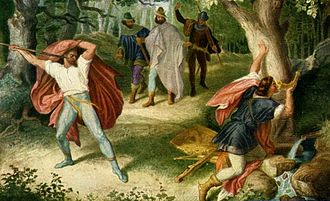Hagen (legend)
Although the Nibelungenlied has a historic center, it was written down only centuries later, in 1200, and therefore incorporated the author's Medieval knowledge and intentions.
However, names that have only a phonetic similarity but no meaningful link with the legend are rejected by scholars, since it is very likely that such connections are random and add nothing to the interpretation of the character.
It is believed that the poet of the Nibelungenlied accepted Tronje as a real place name in the Burgundian kingdom; but it is questionable that he himself knew its exact location, since the story's many geographical mistakes suggest that his knowledge of the area around Worms was not particularly good.
[2] In these forementioned accounts, it is Hagen who kills the hero Siegfried during a hunt, wounding him on the only part of his body which was not invulnerable.
Hagen refuses to reveal the hiding place of the Nibelung treasure to Kriemhild as long as his king Gunther lives.
In the opera Götterdämmerung, part of The Ring Cycle, Hagen is portrayed as the half-brother of Gunther and Gutrune, illegitimately fathered by the dwarf Alberich.
The great German bass Kurt Moll pointed out that Hagen's music is unique in the bass repertoire: it requires a shouting, blaring vocal technique which risks damaging the singer's voice; only very large-voiced, powerful singers can sing it.


Karl Schmoll von Eisenwerth (1911)
